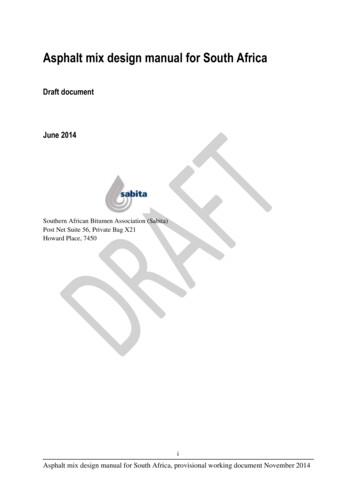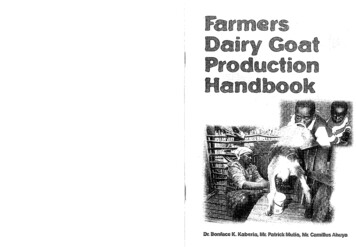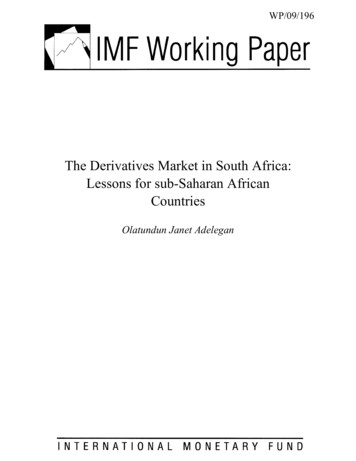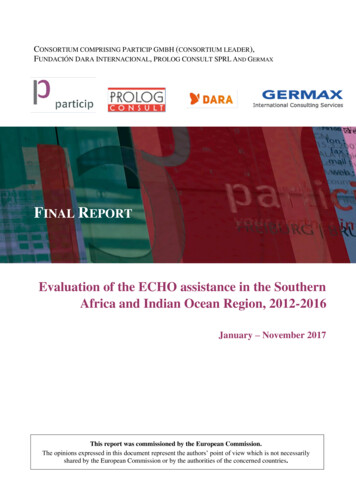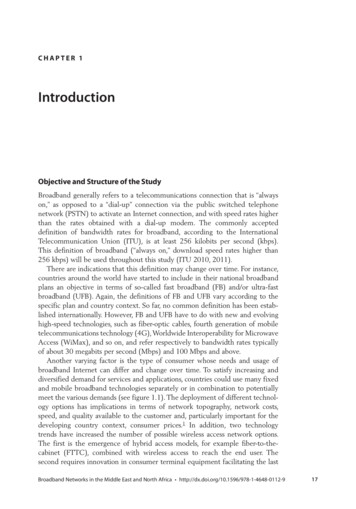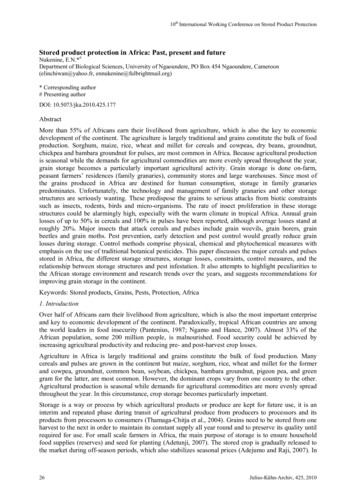
Transcription
10th International Working Conference on Stored Product ProtectionStored product protection in Africa: Past, present and futureNukenine, E.N.*#Department of Biological Sciences, University of Ngaoundere, PO Box 454 Ngaoundere, Cameroon(elinchiwan@yahoo.fr, ennukenine@fulbrightmail.org)* Corresponding author# Presenting authorDOI: 10.5073/jka.2010.425.177AbstractMore than 55% of Africans earn their livelihood from agriculture, which is also the key to economicdevelopment of the continent. The agriculture is largely traditional and grains constitute the bulk of foodproduction. Sorghum, maize, rice, wheat and millet for cereals and cowpeas, dry beans, groundnut,chickpea and bambara groundnut for pulses, are most common in Africa. Because agricultural productionis seasonal while the demands for agricultural commodities are more evenly spread throughout the year,grain storage becomes a particularly important agricultural activity. Grain storage is done on-farm,peasant farmers’ residences (family granaries), community stores and large warehouses. Since most ofthe grains produced in Africa are destined for human consumption, storage in family granariespredominates. Unfortunately, the technology and management of family granaries and other storagestructures are seriously wanting. These predispose the grains to serious attacks from biotic constraintssuch as insects, rodents, birds and micro-organisms. The rate of insect proliferation in these storagestructures could be alarmingly high, especially with the warm climate in tropical Africa. Annual grainlosses of up to 50% in cereals and 100% in pulses have been reported, although average losses stand atroughly 20%. Major insects that attack cereals and pulses include grain weevils, grain borers, grainbeetles and grain moths. Pest prevention, early detection and pest control would greatly reduce grainlosses during storage. Control methods comprise physical, chemical and phytochemical measures withemphasis on the use of traditional botanical pesticides. This paper discusses the major cereals and pulsesstored in Africa, the different storage structures, storage losses, constraints, control measures, and therelationship between storage structures and pest infestation. It also attempts to highlight peculiarities tothe African storage environment and research trends over the years, and suggests recommendations forimproving grain storage in the continent.Keywords: Stored products, Grains, Pests, Protection, Africa1. IntroductionOver half of Africans earn their livelihood from agriculture, which is also the most important enterpriseand key to economic development of the continent. Paradoxically, tropical African countries are amongthe world leaders in food insecurity (Pantenius, 1987; Ngamo and Hance, 2007). Almost 33% of theAfrican population, some 200 million people, is malnourished. Food security could be achieved byincreasing agricultural productivity and reducing pre- and post-harvest crop losses.Agriculture in Africa is largely traditional and grains constitute the bulk of food production. Manycereals and pulses are grown in the continent but maize, sorghum, rice, wheat and millet for the formerand cowpea, groundnut, common bean, soybean, chickpea, bambara groundnut, pigeon pea, and greengram for the latter, are most common. However, the dominant crops vary from one country to the other.Agricultural production is seasonal while demands for agricultural commodities are more evenly spreadthroughout the year. In this circumstance, crop storage becomes particularly important.Storage is a way or process by which agricultural products or produce are kept for future use, it is aninterim and repeated phase during transit of agricultural produce from producers to processors and itsproducts from processors to consumers (Thamaga-Chitja et al., 2004). Grains need to be stored from oneharvest to the next in order to maintain its constant supply all year round and to preserve its quality untilrequired for use. For small scale farmers in Africa, the main purpose of storage is to ensure householdfood supplies (reserves) and seed for planting (Adetunji, 2007). The stored crop is gradually released tothe market during off-season periods, which also stabilizes seasonal prices (Adejumo and Raji, 2007). In26Julius-Kühn-Archiv, 425, 2010
10th International Working Conference on Stored Product Protectionthe dry Sahelian countries in the northwest of Africa, crop storage is a matter of subsistence and survival(Mikolo et al., 2007).Three techniques of storage involving different structures have been identified in Africa (Adesuyi et al.,1980; Udoh et al., 2000), namely: traditional/local grain storage at the farm and domestic level whichincludes local cribs and rhombus, platforms, open fields, roofs and fire places; improved/semi moderngrain storage techniques at farm and domestic level which are ventilated cribs, improved rhombus andbrick bins; and modern centralized storage at the commercial level involving silos and warehouses. Sincefarming is mostly done by subsistence farmers, the first two storage techniques predominate. Storedgrains may suffer from serious attacks from pests (insects, fungi, rodents and birds), especially when notprotected and in the presence of poor store hygiene.In the tropical countries, Hill (1975) listed 407 insect species of major and 788 of minor importanceoccurring in 48 major groups on stored products. Fleurat-Lessard (1988) stated that all grain and seedinsect species belong to two principal orders: Coleoptera and Lepidoptera, with some minor speciesbelonging to the order Psocoptera. Traditionally, the grain weevils, Sitophilus spp. (Coleoptera:Curculionidae) and the Angoumois grain moth, Sitotroga cerealella (Olivier) (Lepidoptera: Gelechiidae)on cereals and three genera of bruchids, Acanthoscelides, Zabrotes and Callosobruchus spp. on pulses arethe most important pests of stored grain in Africa (Abate et al., 2000). In addition to direct destruction ofgrains through feeding and reproduction, insects’ presence has direct influence on grains causing anincrease in grain temperature and moisture contents which leads to an increase in respiration andconsequently loss in quantity and quality of the grain (Odogola, 1994). Grain losses caused by insectpests in Africa are quite high and vary from country to country and from region to region. However,annual grain losses of over 50% (Abraham and Firdissa, 1991) in cereals and up to 100% (Boeke, 2002)in pulses have been reported, although the average stands at 20% (Youdeowi and Service, 1986; Philipsand Throne, 2010). In general, the damage caused by insects is much higher than those caused by otheragents like rodents and micro-organisms. Fungi are the major microorganisms causing spoilage in storedgrains and seeds, resulting in significant losses to farmers, traders and food and feed manufacturers(Twiddy, 1994). The major grain storage fungi are Aspergillus, Fusarium and Penicillium spp. Rodentspecies that damage stored products when they are searching for food water or better leavingenvironments vary from region to region and from country to country. The three common species acrossAfrica are the black rat, Rattus rattus, Fischer de Waldheim, brown rat, Rattus norvegicus, (Berkenhout)and common mouse, Mus musculus L. Pest control are mainly traditional and also the use of syntheticchemicals.This review presents the major cereals and pulses stored in Africa, the different storage structures,storage losses, constraints, control measures, and the relationship between storage structures and pestinfestation. It also attempts to highlight peculiarities to the African storage environment and researchtrends over the years, and suggests recommendations for improving grain storage in the continent.2. Fundamentals of the African storage environment2.1. Stored commoditiesGenerally, over 70% of grains harvested in Africa are stored for human consumption or for marketing(Mallamaire, 1965; Talabi, 1989). In the Sudan and Guinea Savanna of Nigeria 40-85% of grainsharvested are stored (Ivbijaro, 1989). The commodities stored and their relative quantities are generallyrelated to their production statistics - the higher the quantity produced, the more grains of thatcommodity stored. Familiarity with the map of the agro-ecological zones of Africa is important at thispoint since crop production patterns are related to the different zones (Fig. 1).Julius-Kühn-Archiv, 425, 201027
10th International Working Conference on Stored Product ProtectionFigure 1Major agro-ecological zones of sub-Saharan Africa (from Geddes, 1990): 1.) The Sahel (A2):characterized by erratic rainfall of 250 to 500 mm per annum, more than 8 months of dry season, andaltitudes of less than 900 m above sea level. 2.) The Sudan savannah (A3): rainfall 500 to 900 mm, dryseason 8 months, altitude less than 900 m above sea level. 3.) The Guinea savannah (A4): rainfall 900to 1500 mm (mostly unimodal), dryseason of 5 to 7 months, altitude less than 900 m above sea level.4.) The forest–savannah transition (A4/5): rainfall 1300 to 1800 mm (unimodal or bimodal), dry seasonof 4 months, altitude more than 900 m above sealevel. 5.) The forest (A5): rainfall 1500 to 4000 mm,virtually no dry season, altitude less than 900 m above sea level. 6.) The east coast (A6): rainfall 750 to1500 mm (bimodal in some countries), altitude less than 900 m above sea level. 7.) The semi-arid eastand south (A7): rainfall 250 to 750 mm, more than 8 months of dry season, altitude less than 1500 mabove sea level. 8.) The plateaux (B7): rainfall 750 to 1500 mm (mostly unimodal), dry season 5 to 8months, altitude 900 to 1500 m above sea level. 9.) The Uganda and Lake Victoria shore (L1): rainfall1000 to 1500 mm (bimodal), altitude 1135 to 1300 m above sea level. 10.) The mountain (B2): rainfall750 to 1800 mm (unimodal or bimodal), altitude more than 1500 m above sea level.Cereals like maize, sorghum, rice, wheat, millet are important in many African countries, generallyfeaturing among the first five cereals and first 15 crops in terms of production (Table 1) (FAOSTAT,2007). Barley production is high in the Southern (3rd cereal and 17th crop) and Northern Africancountries (4th cereal and 12th crop). Oats appears to be common only in Lesotho (4th cereal and 9thcrop) and teff in Ethiopia and Eritrea. Maize is the leading cereal crop across Africa, while millet and/orsorghum dominate in many countries in the drier areas of the continent like Burundi, Eritrea and Ethiopiain the east, Cameroon and Chad in the middle, Sudan in the north, and Nigeria, Niger, Ghana, Benin,Gambia, Burkina Faso, Senegal, Mali and Guinea in the West. In the dryer parts of Southern Africa (inAngola, Namibia, Zimbabwe, Botswana, Zambia and South Africa), millet is traditionally grown as astaple and surpluses are hardly traded (Smith, 1991). The more developed and sophisticated countries inAfrica, characterized by arid or semi-arid sub-tropical warm climate like South Africa (2nd cereal and4th crop) in the south and most of the countries in the north (Algeria (1st cereal and 1st crop), Egypt (1stcereal and 3rd crop), Libya (1st cereal and 8th crop), Morocco (1st cereal and 2nd crop), Tunisia (1stcereal and 1st crop), wheat is a dominant cereal crop (FAOSTAT, 2007). Wheat production is also highin Ethiopia (1st cereal and 4th crop), Kenya (2nd cereal and 15th crop), Sudan (2nd cereal and 3rd crop)and Zambia (2nd cereal and 5th crop).28Julius-Kühn-Archiv, 425, 2010
10th International Working Conference on Stored Product ProtectionTable 1The top four cereal crops in AfricaAreaCropProductionRankingaWorldAfricaEastern AfricaMiddle AfricaNorthern AfricaSouthern AfricaWestern 7275806119509891 (2)1 (3)1 (3)1 (2)3 (8)1 (2)3 (5)WorldAfricaEastern AfricaMiddle AfricaNorthern AfricaSouthern AfricaWestern 71213427263minor2 (5)3 (10)2 (10)3 (8)5 (18)2 (4)WorldAfricaEastern AfricaMiddle AfricaNorthern AfricaSouthern AfricaWestern or84458292 (3)3 (7)2 (9)5 (15)2 (5)minor4 (6)Worldwheat6111016643 (4)Africa185903674 (8)Eastern Africa37741284 (12)Middle AfricaminorminorNorthern Africa136303931 (2)Southern Africa19220262(4)Western Africa19220262(4)Compiled from FAOSTAT 2007; a Figure without bracket is rank among cereal crops and figure within brackets is rankamong all cropsCowpea, groundnut, common bean, soybean, chickpea, bambara groundnut, pigeon pea and green gramare the more common pulses grown in Africa. Nigeria (2,800,000 Mt), Niger (1,001,139 Mt), BurkinaFaso (253,190 Mt), Cameroon (95,000 Mt) and Kenya (83,251 Mt) are respectively the 1st, 2nd, 3rd, 5thand 6th producer of cowpea in the world (FAOSTAT, 2007). Tanzania (7th in the world), Uganda (8th),Kenya (9th), Rwanda (13th) and Ethiopia (15th) for dry bean, Ethiopia (1st), Chad (2nd), Tunisia (7th),South Africa (9th) and Tanzania (11th) for chickpea, Nigeria (3rd), Sudan (8th), Ghana (10th), CongoDR (11th) and Senegal (12th) for groundnut, Malawi (3rd), Kenya (4th), Uganda (5th), Tanzania (6th)(1st cereal and 2nd crop), and Congo DR (9th) for pigeon pea, and Nigeria (13th) and South Africa(19th) for soybean are the highest producing countries in Africa.2.2. Length of storageGrain storage periods generally range between 3 and 12 mo across Africa. The length of storage dependson the agro-ecological zone, ethnic group, the quantity of commodity stored, the storage condition, thecrop variety stored, etc. (Hell et al., 2000; Ngamo et al., 2007). The length of storage of grains tends tobe longer in the dryer areas of Africa. Ngamo et al. (2007) reported an increase in storage length from 38 months in the Sudano-Guinean Agro-ecology to over 24 months in the Sudano-Sahelian zone ofCameroon. In the Northern Guinea Savanna of Benin, maize is usually stored between 3 and 8 monthsand in the Sudan Savanna 7-12 months (Hell et al., 2000). Storage for 5-12 months is common in theJulius-Kühn-Archiv, 425, 201029
10th International Working Conference on Stored Product ProtectionForest/Savanna Mosaic and the Southern Guinea Savanna of Benin. In the Forest/Savanna Mosaic, a fewfarmers store maize for more than 12 months. In this area, dominated by the “Mina” ethnic group, thesize of maize stores is used to assess the wealth and social prestige of their owners and maize can bestored for up to 3 years (Smith, 1991).The length of grain storage in the Sudan and Guinea Savanna of Nigeria is between 5 and 12 mo, exceptfor soybean with usually less than 5 months storage because of its high demand (Ivbijaro, 1989).However, a maximum storage period of between 7 and 10 years for sorghum and millet in the SudanSavanna was recently reported by Adejumo and Raji (2007). In Namibia, Keyler (1996) reported that thefear of the effect of drought made farmers store grains from 4 to 6.5 years.2.3. Storage structuresThe structure used for grain storage depends on the level of storage: On-farm, village and city or central.On farm storage involves individuals, while village storage may implicate individuals (family granary) ora group of individuals (community stores) (Fig. 2). The city and central storage facilities include largewarehouses and are usually own by government agencies or non-governmental organizations (national orinternational). They are usually built with expertise from the developed world. Since most grains inAfrica are produced by rural farmers, storage at the farm/village level will be emphasized in this paper. Itis also at this level that traditional structures typical to Africa could be better discerned.30Open Platform (Cameroon)Woven basket (Cameroon)Woven Basket (Burkina Faso)Pots (Cameroon)Mud Rhombu (Cameroon)Mud Rhombu (Nigeria)Julius-Kühn-Archiv, 425, 2010
10th International Working Conference on Stored Product ProtectionMaize Crib, Bamboo and straw roof (Madagascar)Figure 2Community store (Cameroon)Common storage structures in Africa.Many publications have reported on traditional storage structures in Africa (Gilman and Boxall, 1974;Youdeowei and Serive, 1986; FAO, 1994; Adejumo and Raji, 2007). These storage facilities are made oflocal materials (plant materials and soil) and constructed by the villagers themselves. Some structures areused for temporary storage (mostly intended for the drying of the crop), while others are for long-termstorage (FAO, 1994). Temporary storage methods are grouped into aerial storage (maize cobs orsorghum and millet panicles are sometimes tied in bundles, which are then suspended from tree branches,posts, or tight lines on or inside the house), storage on the ground, or on drying floors and open timberplatforms. Long-term storage methods include (i) storage baskets (cribs or thatched rhombus) madeexclusively of plant materials, (ii) calabashes, gourds, earthenware pots, etc., (iii) jars, (iv) solid wall bins(mud rhombus), and (v) underground storage.In humid countries, where grain cannot be dried adequately prior to storage and needs to be kept wellventilated during the storage period, traditional granaries (cribs) are usually constructed entirely out oflocally available plant materials: timber, reeds, bamboo, etc (Fig. 2). The small capacity containers(calabashes, gourds, earthenware pots, etc.) are most commonly used for storing seed and pulse grains,such as cowpeas. If the grain is dry (less than 12% moisture content) there is usually no problem withthis kind of storage. Jars are generally kept in dwellings; they serve equally for storing seeds andlegumes.A solid wall bin or mud rhombus is a specially built structure from a mixture of clay and dry straw(Adejumo and Raji, 2007). It consists of a bin resting on large stones, timber or earth. Such grain storesare usually associated with dry climatic conditions, under which it is possible to reduce the moisturecontent of the harvested grain to a satisfactory level simply by sun-drying it. Solid wall bins are thereforetraditional in the Sahel region of Africa, and in southern African countries bordering on the KalahariDesert (FAO, 1994). Its shape could be spherical, circular or cylindrical (Adejumo and Raji, 2007).Underground pit storage is practiced in the Sahelian countries and southern Africa, and is used in dryregions where the water table (low) does not endanger the contents. Conceived for long term storage, pitsvary in capacity (from a few hundred kg to 200 t) (FAO, 1994). Their traditional form varies from regionto region: they are usually cylindrical, spherical or amphoric in shape, but other types are known (Gilmanand Boxall, 1974). The entrance to the pit may be closed either by heaping earth or sand onto a timbercover, or by a stone sealed with mud.As with the length of storage, storage structures also vary with the agro-ecological zone, ethnic group,the quantity of commodity stored, the storage condition, etc. Description of the storage structures andhabits in Benin and Namibia highlights some of these variations. Storage structures in the south of Benin(Southern Guinea Savanna) which has a bimodal rainfall pattern differ from the stores used in northernBenin (Northern Guinea Savanna and Sudan Savanna), where the rainfall is unimodal (Fiagan, 1994). Inthe south, stores are constructed out of plant materials, whereas in northern Benin a high percentage ofstores are built of clay (Fiagan, 1994). Fiagan (1994) observed that the storage of maize in anintermediary structure may lead to the contamination of maize with pests and pathogens. Many farmersuse two stores during the storage season, with the initial store built in the field (on-farm). Field stores areJulius-Kühn-Archiv, 425, 201031
10th International Working Conference on Stored Product Protectiontaken down in the dry season from February to April when bush fires and theft, because of depleting foodsto
DOI: 10.5073/jka.2010.425.177 . Pest prevention, early detection and pest control would greatly reduce grain . Mus musculus L. Pest control are mainly traditional and also the use of synthetic .

